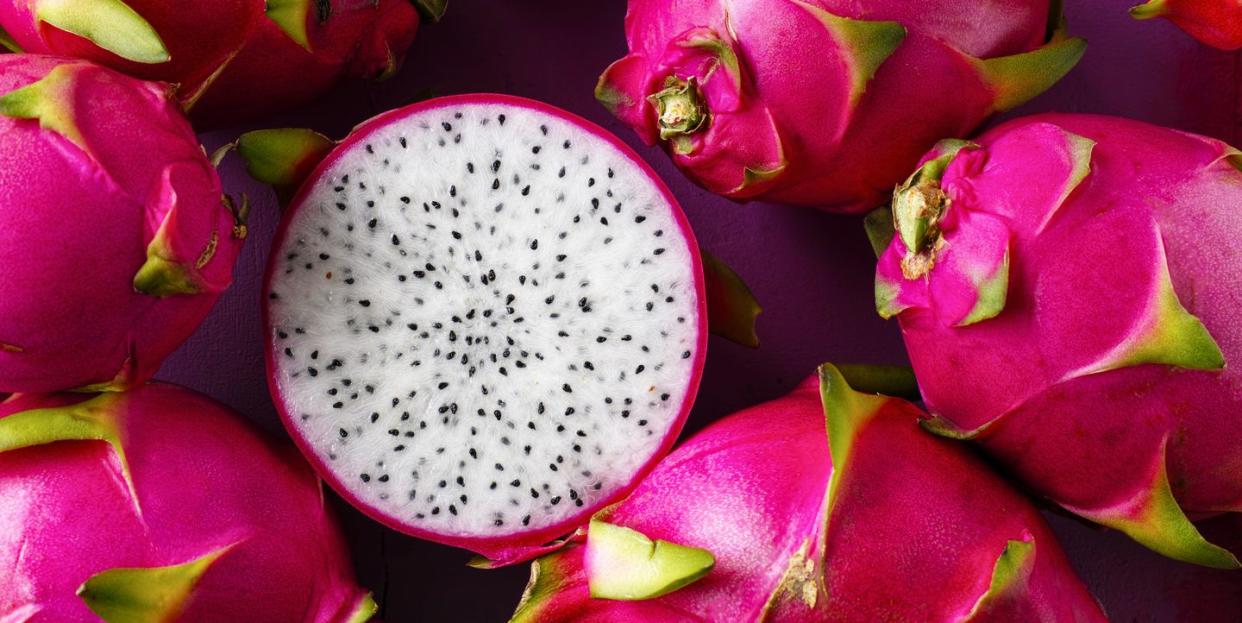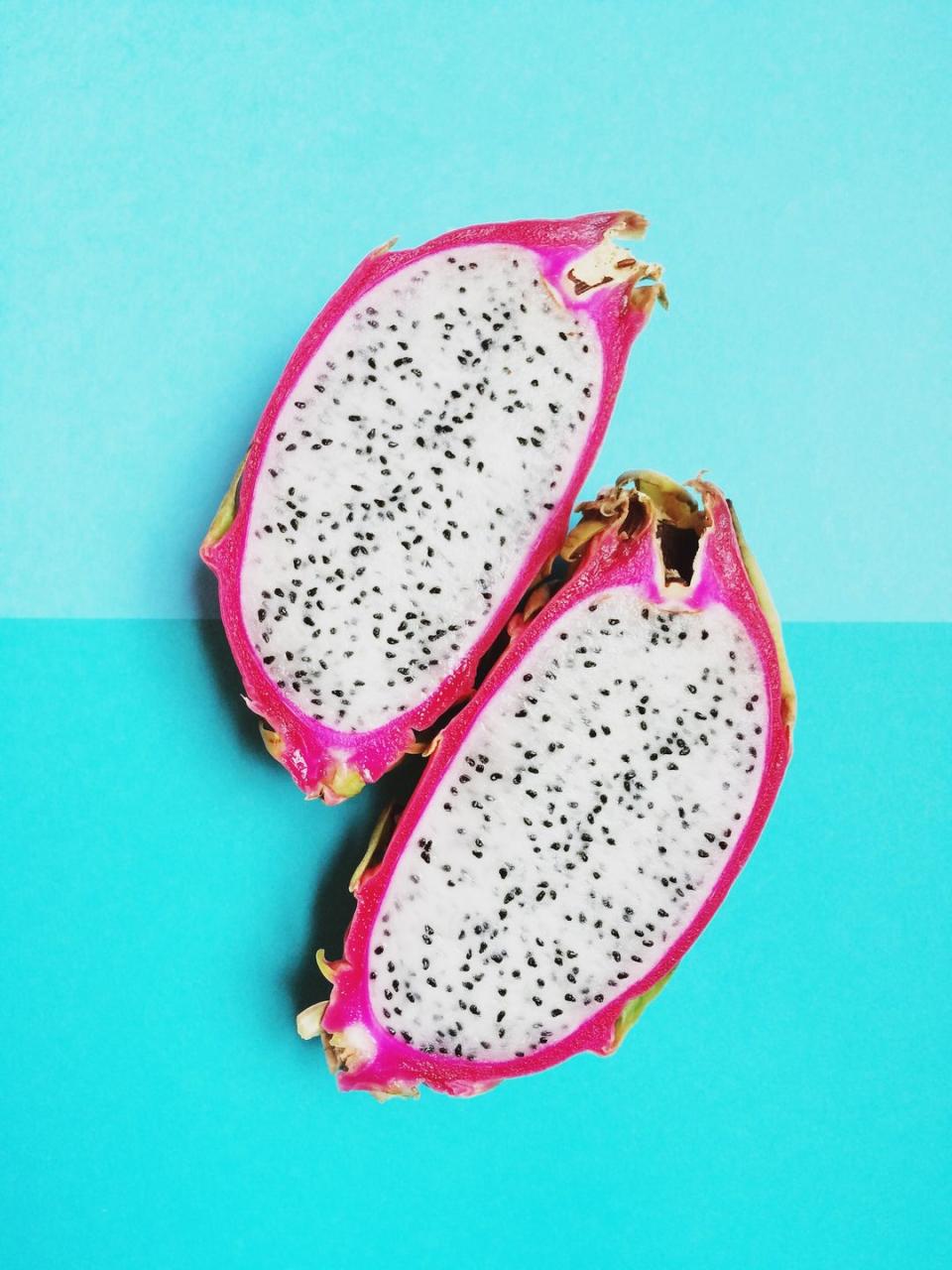Feeling Constipated? Eating Dragon Fruit Can "Clean You Right Out," Per an R.D.

Since dragon fruit is not abundant in the United States, nor is it as widely available in supermarkets as other produce, most Americans are unaware of its incredible flavor and potential health benefits. If you’re curious about what dragon fruit can do for your health, we've got answers.
What is dragon fruit, exactly?
Named for its artichoke-like features, pointy scales and all, dragon fruit is a sweet, tropical fruit with a lil crunch to it. Also commonly referred to as a cactus fruit or strawberry pear, “it tastes a little bit like a kiwi and you can eat it like a kiwi, where you spoon it out,” says Joan Salge Blake, Ed.D., R.D.N., a clinical professor at Boston University and host of the podcast Spot On!.
One dragon fruit is about 60 calories and is a good source of magnesium and vitamin C, says Roxana Ehsani, M.S., R.D., C.S.S.D., L.D.N., a Registered Dietitian Nutritionist and a National Media Spokesperson for the Academy of Nutrition and Dietetics. “I often hear my clients say, I'm bored, I feel like I’m eating the same thing every day, so I point them to the tropical produce section of the grocery store and I encourage them to try one out,” she says. “It’s a great solution for anyone who wants to shake things up in the kitchen.” And even the seeds are healthy! “They add a dose of heart healthy omega-3 and omega-9 fatty acids,” she adds.
Dragon fruit also contains antioxidants like beta-carotene and lycopene, says Salge Blake. Beta-carotene is converted into vitamin A when digested, which supports healthy skin, your immune system, and even your vision. Antioxidants can help ward off chronic diseases, such as cardiovascular issues, cancer, and cataracts.
Why is dragon fruit so expensive?
Yes, like anything rare, dragon fruit is on the pricier side compared to other fruits that are plentiful in the U.S. like oranges and strawberries. One fruit can cost you up to $6 depending on the store, so it helps to buy it in season. The white variety is in season year-round and the bright pink ones are available June through October, per Ehsani.
If you do decide to snag a couple at the store, here are a few more ways dragon fruit can benefit you:
1. It'll get your bowels moving.
One piece of dragon fruit can contain up to 7g of fiber, about a quarter of the recommended daily intake (25-30g), says Salge Blake, and such a potent amount will “clean you right out.” So if you've been suffering from constipation recently, slice it up and enjoy it on its own, make a salsa with it, or add it to a fruit salad or smoothie, says Ehsani. “It has a mild flavor so it won’t be overbearing in any dishes.”
2. It's good for your heart.
Like we mentioned earlier, those seeds aren't just for show! They contain heart healthy omega-3 and omega-9 fatty acids, as noted by Ehsani and a 2018 study published in the World Journal of Pharmacy and Pharmaceutical Sciences. In “omega-3s are thought to have anti-inflammatory properties that may help to decrease risk for heart disease, joint pain, and depression,” Keri Gans, M.S., R.D., a New York-based nutrition consultant and author of The Small Change Diet, previously told Prevention.com.
3. It supports bone health.
Given that dragon fruit has more magnesium than most fruits (about 18% of the recommended daily intake), it can support bone health—particularly in postmenopausal women—according to one study published in the Journal of International Medical Research.

4. It keeps the blood flowing.
Iron is one of the most common nutrient deficiencies in the world, with about 10 million iron-deficient people in the United States. It's also more common in women. We get most of our daily iron intake through meats, fish, nuts, and legumes. But dragon fruit is one of the few fruits that is high in iron (8% of the DRI)—essential for the production of hemoglobin, which assists red blood cells in moving oxygen throughout the body's tissues.
5. It supports healthy hair, skin, and nails.
An iron deficiency can also result in hair loss. (Other iron deficiency anemia symptoms are extreme fatigue, pale skin, difficulty concentrating, headaches, and cold hands and feet, per Gary Goldenberg, M.D., assistant clinical professor of dermatology at the Icahn School of Medicine at Mount Sinai in New York City.) Adding more iron to your diet can stimulate hair growth and simultaneously support healthy skin and nails.
6. It boosts your immune system.
We all turn to vitamin C when we sense the first signs of a flu or cold, but oranges are usually the first fruit we think of. Now, consider boosting your immune system with dragon fruit, which is also high in vitamin C, says Ehsani. Not only that, but “fruits and veggies help arm your body with antioxidants it needs to fight oxidative stress, which includes contracting a sickness, in your body,” Beth Warren, R.D., founder of Beth Warren Nutrition and author of Secrets of a Kosher Girl, previously told Prevention.com.
Support from readers like you helps us do our best work. Go here to subscribe to Prevention and get 12 FREE gifts. And sign up for our FREE newsletter here for daily health, nutrition, and fitness advice.
You Might Also Like

